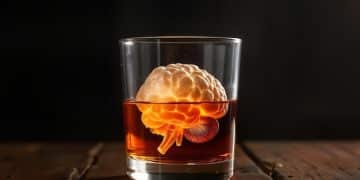Addiction Recovery: 7 Proven Strategies to Cut Cravings by 40%

Addiction recovery hinges on effectively managing cravings, and implementing strategies such as cognitive behavioral therapy, mindfulness, exercise, support groups, and dietary adjustments can reduce cravings by 40% within the first 90 days, empowering individuals to achieve sustained sobriety.
Embarking on the journey of addiction recovery: 7 strategies to reduce cravings by 40% in the first 90 days may seem daunting, but it’s a reachable goal. Understanding the science behind cravings and implementing proven techniques can dramatically improve your chances of success.
Understanding Addiction and Cravings
Addiction is a complex condition that affects both the brain and behavior. Cravings are intense urges to use a substance and are a significant barrier to successful recovery.
The Science of Cravings
Cravings aren’t just psychological; they’re rooted in neurochemical processes. Substances alter the brain’s reward pathways, leading to intense desires when the substance is absent.
Understanding these biological underpinnings is crucial. It highlights that cravings are not a sign of weakness but a symptom of a brain adapting to substance use.
Common Triggers for Cravings
Identifying triggers is a vital first step in managing cravings. Triggers can be environmental, emotional, or social.
- Stressful situations or environments
- Exposure to cues associated with past substance use
- Negative emotions like sadness or anger
- Social gatherings where substances are present
Recognizing and avoiding these triggers where possible is key to minimizing the intensity and frequency of cravings. This awareness empowers you to take proactive steps in your recovery.
In conclusion, understanding the science behind cravings and their triggers is crucial for anyone navigating addiction recovery: 7 strategies to reduce cravings by 40% in the first 90 days . This sets the stage for employing effective coping mechanisms.
Strategy 1: Cognitive Behavioral Therapy (CBT)
Cognitive Behavioral Therapy (CBT) is a powerful tool in addiction recovery. It helps individuals identify and change negative thought patterns that contribute to cravings.
CBT provides practical techniques to challenge distorted thinking and develop healthier coping strategies.
How CBT Works
CBT focuses on the connection between thoughts, feelings, and behaviors. By changing negative thought patterns, individuals can alter their emotional responses and behaviors, reducing cravings.
Therapists guide patients in identifying triggers and developing coping mechanisms. This structured approach enables individuals to take control of their thoughts and actions, fostering resilience.
Practical CBT Techniques
Several CBT techniques can be applied to manage cravings effectively.
- Thought records to track and challenge negative thoughts
- Cognitive restructuring to reframe negative thoughts into positive ones
- Behavioral experiments to test the validity of negative thoughts
- Skills training to develop coping strategies for high-risk situations
Consistent practice of CBT techniques empowers individuals to manage cravings effectively. It’s about taking small, consistent steps toward healthier thinking and behavior.

In short, CBT is an evidence-based therapy that equips individuals with the tools they need to manage cravings and sustain long-term recovery within addiction recovery: 7 strategies to reduce cravings by 40% in the first 90 days.
Strategy 2: Mindfulness and Meditation
Mindfulness and meditation are practices that cultivate awareness of the present moment. They offer a powerful way to manage cravings without judgment.
These techniques provide a sense of calm and centeredness, reducing reactivity to cravings.
Practicing Mindfulness
Mindfulness involves paying attention to your thoughts, feelings, and sensations in the present moment. It’s about observing without getting carried away by them.
Simple mindfulness exercises, like mindful breathing, can be practiced anywhere. These practices help individuals become more aware of their internal states, enabling them to respond more effectively.
Benefits of Meditation
Meditation has numerous benefits for addiction recovery. It reduces stress, improves focus, and enhances emotional regulation.
- Reduced stress and anxiety
- Improved attention and concentration
- Increased self-awareness
- Enhanced emotional regulation
Regular meditation practice can lead to profound changes in how individuals relate to their cravings. It’s about finding a sense of peace and stability amidst challenges.
Ultimately, mindfulness and meditation are practical tools for managing cravings and promoting overall well-being during addiction recovery: 7 strategies to reduce cravings by 40% in the first 90 days.
Strategy 3: Regular Exercise
Exercise is not only good for physical health but also a powerful tool for managing cravings. It releases endorphins, which have mood-boosting effects.
A consistent exercise routine helps reduce stress and improve overall well-being.
The Impact of Exercise on Cravings
Exercise reduces cravings by altering brain chemistry. It increases the release of dopamine and serotonin, which counteract the effects of substance withdrawal.
Regular physical activity also distracts from cravings. It provides a healthy outlet for energy and reduces the amount of time spent thinking about substances, contributing positively to addiction recovery: 7 strategies to reduce cravings by 40% in the first 90 days.
Types of Exercise to Consider
The best type of exercise is one you enjoy and can sustain over time.
Consider activities such as:
- Aerobic exercises like running, swimming, or cycling
- Strength training to build muscle and boost metabolism
- Yoga and Pilates for flexibility and stress reduction
The key is to find an activity that fits your lifestyle and preferences. Consistency is more important than intensity.
To summarize, regular exercise is an effective strategy for managing cravings and promoting overall health. It’s a simple yet powerful tool for sustaining recovery.
Strategy 4: Building a Support Network
Having a strong support network is crucial for addiction recovery. Isolation can exacerbate cravings; connection provides strength and accountability.
Support can come from family, friends, support groups, or therapists.
The Importance of Social Support
Social support provides a sense of belonging and reduces feelings of loneliness. Supportive relationships offer encouragement and understanding during challenging times.
- Reduces isolation and loneliness
- Provides encouragement and understanding
- Offers accountability and support for sobriety
Connecting with others who understand your struggles can be incredibly validating. It reminds you that you are not alone on your journey.
Joining Support Groups
Support groups like Alcoholics Anonymous (AA) or Narcotics Anonymous (NA) offer a structured environment for sharing experiences and receiving support.
These groups provide a safe space to discuss challenges, share coping strategies, and build relationships with peers. The sense of community can be life-changing.

In essence, building a robust support network is an essential component of addiction recovery: 7 strategies to reduce cravings by 40% in the first 90 days. It provides the strength and resilience needed to navigate challenges.
Strategy 5: Nutrition and Diet
Nutrition plays a significant role in addiction recovery. A balanced diet can stabilize mood, reduce cravings, and improve overall health.
Substance use often leads to nutritional deficiencies, which can exacerbate withdrawal symptoms.
The Link Between Diet and Cravings
Poor nutrition can contribute to cravings by disrupting blood sugar levels and neurotransmitter function. A diet high in processed foods and sugar can lead to mood swings and increased cravings.
Conversely, a balanced diet rich in nutrients can stabilize mood and reduce cravings. It’s about fueling the body and brain with the right building blocks.
Foods to Include and Avoid
Focus on consuming whole, unprocessed foods. Include:
- Lean proteins to stabilize blood sugar
- Complex carbohydrates for sustained energy
- Healthy fats for brain function
- Fruits and vegetables for vitamins and minerals
Avoid processed foods, sugary drinks, and excessive caffeine. These can trigger cravings and disrupt overall health.
Overall, nutrition and diet are vital components of addiction recovery: 7 strategies to reduce cravings by 40% in the first 90 days. A balanced diet stabilizes mood and reduces cravings.
Strategy 6: Avoiding Temptation and Triggers
Actively avoiding temptation and triggers is a practical step in managing cravings. Minimizing exposure to cues associated with past substance use reduces the likelihood of relapse.
This strategy involves making conscious choices to create a safer and more supportive environment.
Identifying and Eliminating Triggers
The first step is to identify your personal triggers. Triggers can be people, places, or things associated with your past substance use.
Once identified, take steps to eliminate or minimize these triggers. This may involve changing your social circle, avoiding certain locations, or removing certain items from your home.
Creating a Supportive Environment
Creating a supportive environment involves surrounding yourself with positive influences and removing negative ones.
- Spend time with supportive friends and family
- Avoid places where substances are present
- Create a substance-free home environment
By proactively managing your environment, you reduce the risk of encountering triggers and increase your chances of sustained recovery. This can have strong benefits for addiction recovery: 7 strategies to reduce cravings by 40% in the first 90 days.
Strategy 7: Using Medication (If Necessary)
Medication-Assisted Treatment (MAT) can be an effective component of addiction recovery. Medications can reduce cravings, manage withdrawal symptoms, and prevent relapse.
MAT should be used in conjunction with therapy and other support services.
Types of Medications Used in MAT
Several medications are approved for use in MAT, depending on the substance and individual needs.
Examples include:
- Naltrexone to block the effects of opioids and alcohol
- Buprenorphine to reduce cravings and withdrawal symptoms for opioids
- Acamprosate to reduce cravings for alcohol
These medications work by targeting specific brain pathways involved in addiction. They can significantly reduce cravings and make it easier to maintain sobriety.
Consulting with a Healthcare Professional
MAT should only be initiated under the guidance of a healthcare professional. A doctor can assess your individual needs and determine the most appropriate medication and dosage.
Regular monitoring and adjustments may be necessary. It’s important to follow your doctor’s instructions carefully.
“`html
| Key Point | Brief Description |
|---|---|
| 🧠 CBT | Changes negative thought patterns. |
| 🧘 Mindfulness | Cultivates present moment awareness. |
| 💪 Exercise | Releases endorphins, reduces stress. |
| 🤝 Support | Provides encouragement and accountability. |
“`
FAQ
▼
Common addiction triggers include stress, social situations with substance use, exposure to cues like paraphernalia, and certain emotional states such as sadness or anxiety. Identifying these triggers is crucial for relapse prevention.
▼
Exercise helps by releasing endorphins, which can improve mood and reduce cravings. It also provides a healthy distraction from substance use and improves overall physical and mental health.
▼
CBT is a type of therapy that helps individuals identify and change negative thought patterns and behaviors. It teaches coping strategies to manage cravings and prevent relapse by addressing the root causes of addiction.
▼
A support network provides encouragement, understanding, and accountability. It reduces feelings of isolation, offers practical advice, and helps individuals stay motivated on their recovery journey by providing a sense of community.
▼
A healthy diet stabilizes blood sugar, reduces cravings, and improves overall health. Avoiding processed foods and sugary drinks can minimize mood swings and triggers, while nutrient-rich foods support brain function and emotional stability.
Conclusion
In conclusion, addiction recovery: 7 strategies to reduce cravings by 40% in the first 90 days encompasses understanding addiction and cravings , CBT, mindfulness, exercise, a strong support network, proper nutrition, avoiding triggers, and considering medication. Together, these strategies provide a multifaceted approach to conquering cravings and achieving lasting sobriety.





